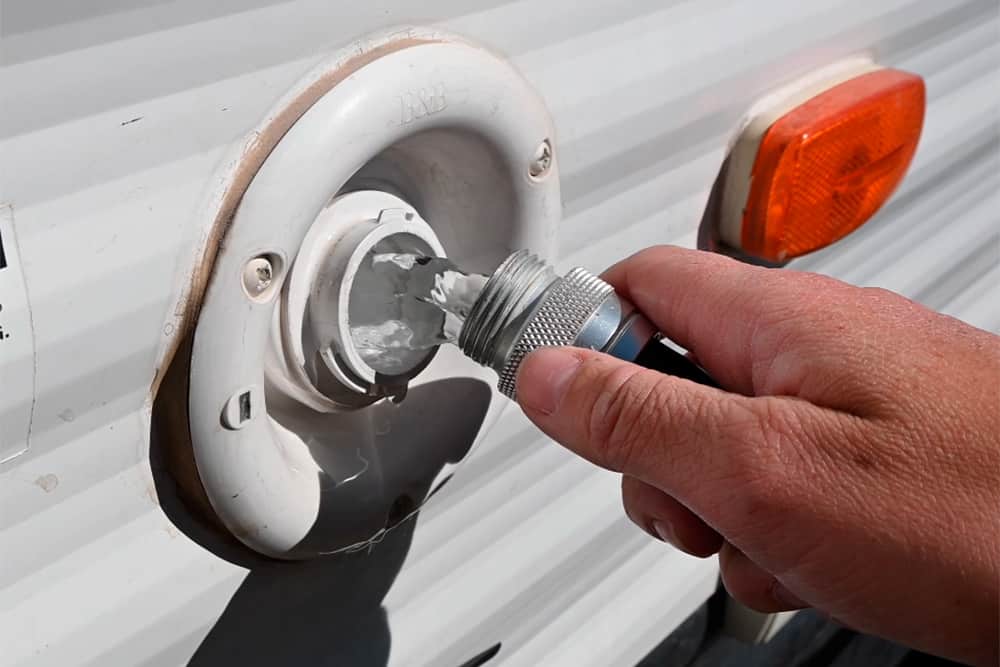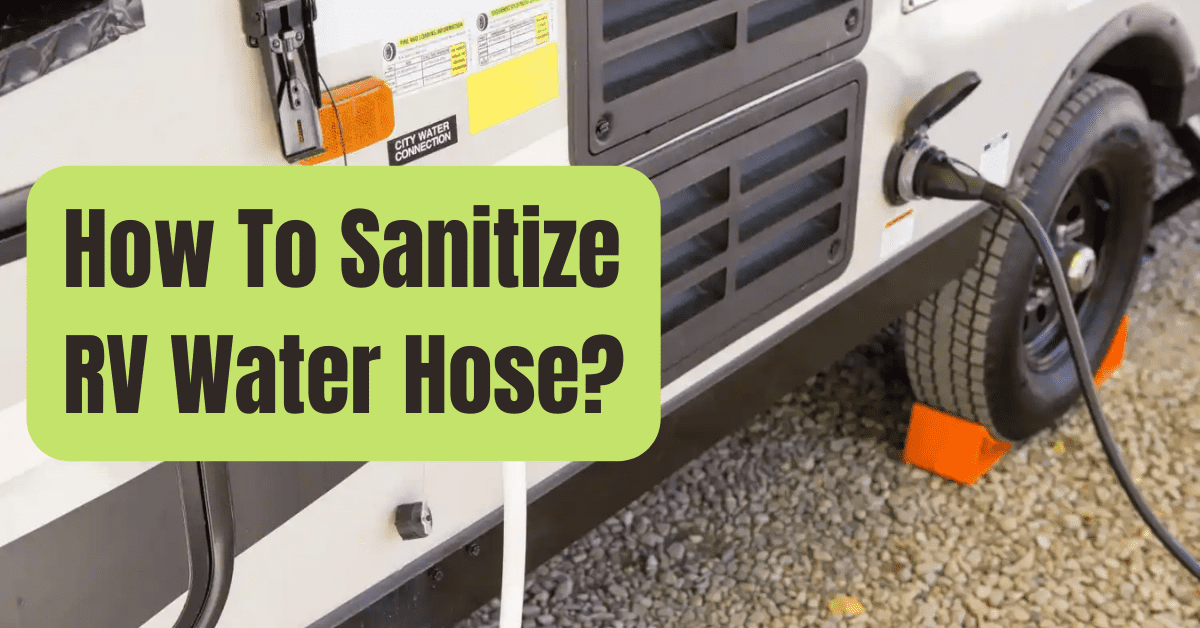How to Clean a Fresh Water Tank in an RV
If you were to go to a park and ask everyone you come across how often they clean their RV camper’s fresh water holding tank and water system.
Less than half of them would likely even understand what you’re talking about.
Everyone should sanitize their RV’s water system at least once each year.
For safety, taste, and odor reasons, you should sterilize your camper if you pull it out of storage or if the fresh water tank has had water in it for many months without being used or washed thoroughly.
A few times, all you need to do is smell the water to know.
It’s time if anything smells off.
Even if you don’t consume the water flowing from your taps and shower, it’s still necessary to keep your RV tanks and water system/lines clean.
You should maintain your water system and storage tanks clean if you utilize the water in any manner.
By doing this, you may avoid problems with algae, slime, or dangerous germs that might result in the need to repair your tanks and pipes and cost you a lot of money.
Many individuals avoid doing RV maintenance because they believe it to be too labor-intensive, but cleaning the water system is simple and only needs a little amount of waiting.
We will discuss how it is done now.
How Can You Tell When Your RV’s Water System And Pipes Need To Be Cleaned And Sanitized?
As previously said, if your camper has been in storage, has had water in the fresh water tank for months, or otherwise smells off, it’s time to get out the bleach!
Even if you’ve been to a campsite with questionable-smelling water, you should still sanitize.
When you leave, you should cleanse your water system as soon as possible.
Even if you merely had your water hose attached to the camper’s municipal water input, the water would have passed through all of your pipes and perhaps left germs and other microbes that might later create issues.
Additionally, we advise investing in an RV filtration system to purify water before it reaches your camper.
It goes without saying that you should thoroughly clean your whole water system, including all of the pipes, if you are experiencing an algae or slime issue.
How To Sterilize And Clean Your RV’s Water Lines And System
Cleaning the water system in your RV is a fairly simple and uncomplicated operation.
It is not expensive or labor-intensive to prepare.
You’ll need the following six items:
- Access to drinkable water as well as a location to empty the grey tank -Considering that we are going to repeatedly fill and empty the fresh water tank, it is imperative that we have access to drinkable water as well as a location to empty the water from the grey tank.
- An untarnished fresh water hose
- Regular Bleach (Like Clorox) – This is what will fully clean the whole water system.
- Funnel – This was used to pour our bleach/water mixture into the fresh water tank.
- One Gallon Bottle – You should always mix bleach with water before adding it to your holding tank.
- 1/4 Cup Measuring Cup – For every 15 gallons of fresh water in your holding tank, combine 1/4 cup normal bleach with water. For a 60-gallon holding tank, use 1 cup of bleach, for instance.
Step 1: Verify that you are not using municipal water.
Step 2: Shut off the water heater and pump, then empty the heater.
This is accomplished by removing the drain plug, which is often accessible from the outside by opening the water heater door and is frequently situated in the bottom left corner.
Reinstall the drain stopper when it has been emptied.
Where the water pipes enter the water heater is often where the bypass is positioned.
You must obtain access to the water heater’s interior in order to cut off the hot and cold water pipes and prevent the water heater from refilling once again.
Between them, there ought to be a single valve that you may open to turn off the heater.
Step 3: Open taps and empty the gray water tank to drain the whole water system in your RV.
Step 4: Bypass any internal or external filters in step four.
If at all feasible, switch the filters after sanitizing.
Step 5: Add potable water to your fresh water tank until it is roughly one-third full.
We want it to be partially filled but not completely filled; it doesn’t have to be precise.
Step 6: We will now prepare our bleach mixture.
1/4 cup for every 15 gallons is what we need.
Use 3/4 cup in total if your water tank holds 45 gallons.
The one-gallon container should first be filled with potable water before adding bleach.
Step 7: Add the freshly prepared mixture to your fresh water storage tank.
then nearly completely fill your fresh water tank with drinkable water.
Step 8: Your RV’s water heater valves may now be opened, your water pump turned on, and one faucet at a time turned on.
When the water in your water lines starts to smell like bleach, switch off the bleach water and go to the next step.
After a minute or two, bleach should start to smell.
Step 9: We must now wait.
It is advised to wait at least three hours.
I typically let the bleach 12 hours to do its thing.
Step 10: Start the draining procedure after X hours have elapsed.
Leave the grey tank valve open when emptying the tank once you’ve opened it and emptied it.
Step 11: Restart your water pump and all of your faucets.
Wait until your fresh water holding tank is empty before letting them pass through your water pipes.
Step 12: Repeat Steps 11 through 11 while adding new water to the holding tank.
Fill and dump the container until the water flowing from your faucets no longer smells like bleach.
I also advise using the plug to empty the hot water heater once more.
Step 13: When there is no more bleach odor, you are finished!
By turning on the hot water faucet in your kitchen sink, you can check sure there is no air in your water heater before turning it back on.
If the water heater is switched on with air inside of it, harm might easily result.

FAQs
Will it take less time if I use twice as much bleach?
No, using twice as much bleach won’t increase its efficacy or speed up its process.
If you won’t have access to potable water or have adequate time, don’t start the procedure.
Can I clean and sterilize my black tank with bleach?
While I do not advise using bleach in your black tank, RV holding tank cleaners like Happy Campers Organic RV Holding Tank Treatment (click to see on Amazon) can assist in cleaning the tank and decomposing any waste that has accumulated there.
What sort of bleach works best to disinfect the water system in an RV?
Nonscented, non-gel chlorine bleach.
Is it okay to pour bleach directly into my fresh water holding tank without first combining it with water?
No, this won’t be beneficial for your holding tank or water pipes.
First, combine it with water.
How can the RV water system and pipes be cleaned and sanitized without using bleach?
Instead of using bleach, you may use TastePURE, a combination that Camco manufactures (click to see
on Amazon).
The container itself contains the directions about how to accomplish it.
These are also being sold at standard retailers, as far as I know.
How can the fresh water holding tank in an RV’s water pipes be sanitized separately?
Pumping the bleach and water mixture into your municipal water connection will clean the water lines in your camper but not the freshwater holding tank.
To achieve this, you’ll need a portable water pump.
Alternatively, you might attach the water line to your municipal water supply, fill it with the bleach and water solution, hold it up so it remains inside, connect it to drinkable water, and turn it on.
Then turn off your faucets once they begin to smell like bleach and wait at least three hours before turning them back on.
Then just run the faucets while rinsing the lines.
To prevent an overflow, keep the grey tank valve open.
How often should I clean the water system in my RV?
I advise doing it twice a year if you live in your RV full-time.
Bring your trailer out once in the spring even if you only camp throughout the summer.
What water filtering system for RVs do you suggest?
You may discover our article on the top RV water filtration systems by clicking here!
How can I clean the sewage hose on my RV?
I use a solution of bleach and water to clean the sewage line on my RV.
I combine bleach and water, plug one end of the sewage pipe, and pour the mixture in.
After almost completely filling it with water, I placed another cover on the open end.
After letting it lie for a couple of hours, I rinsed it with water.
If you can do it without caps, you can combine bleach and water in a bucket large enough to accommodate your whole sewage pipe.
The sewage hose should be completely submerged in the mixture, left on for the full night, then sprayed clean and thoroughly rinsed.
How can I clean the fresh water hose on my RV?
The fresh water hose for an RV may be sanitized in the same manner as the sewage hose to ensure that it is clean and free of bacteria and germs.
In a clean container, combine water and bleach (approximately 1/4 cup), then immerse the hose.
After leaving it overnight, rinse it off with the hose and a stream of water.
How hazardous is it to handle bleach?
While not harmful, bleach may irritate the mouth, eyes, skin, lungs, and skin.
It shouldn’t be consumed.
Mostly, you need to be cautious to prevent getting bleach on your clothes or hair since it will, as you would have imagined, bleach them.
Additionally, be careful to remove any bleach that may be in the freshwater tank or water pipes.
It is worth it to have everything cleaned out, even if you have to refill the tank and rinse a few times.
After thoroughly cleansing them all, my water system, pipes, and hoses still smell like bleach, what can I do?
You may produce a solution with 1/2 cup baking soda and 1 gallon of water if your RV’s water system, lines, or any hose still smell like bleach after many rinses.
Run your faucets while you pour the mixture into your fresh water holding tank so that it may reach all of your RV’s water lines.
Give it a few hours to sit.
Run the water until the tank is empty and then replenish it.
Make a mixture (perhaps using several gallons) and soak the hoses in it.
Wait a few hours, then rinse through the hoses until the mixture no longer smells like bleach.










